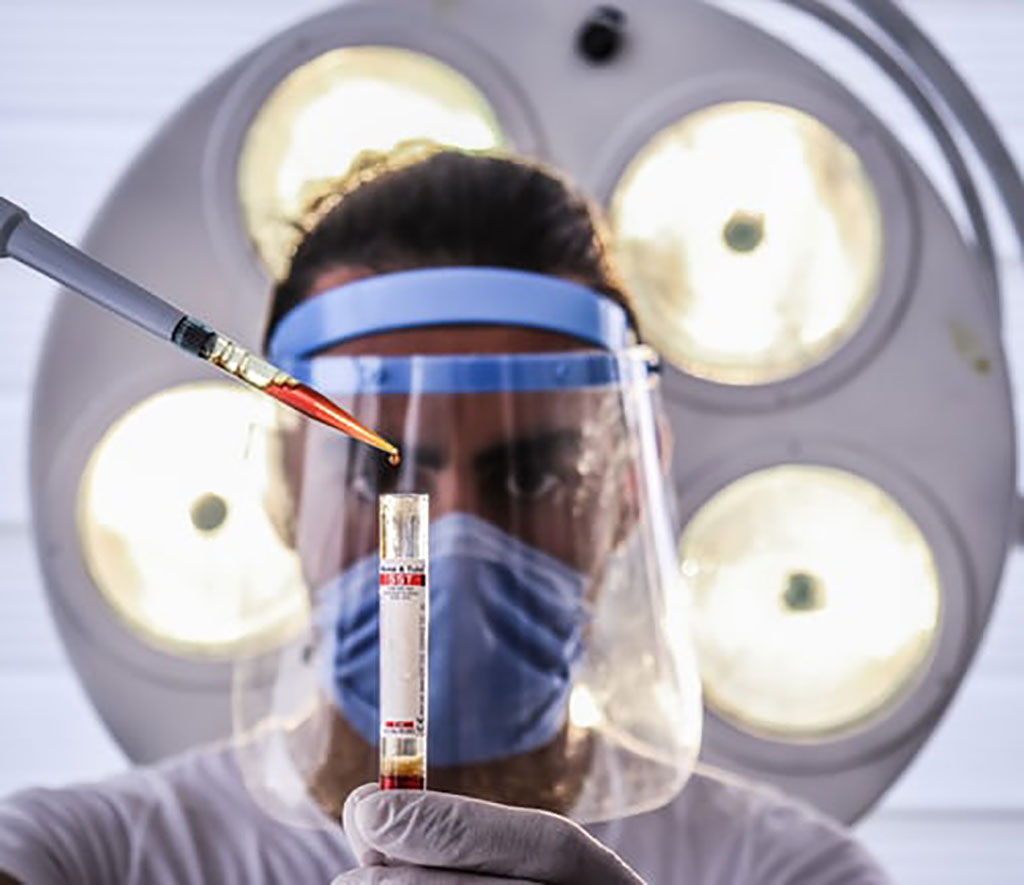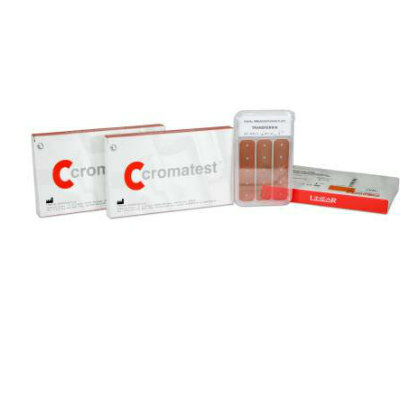Blood Test Helps Predict Who May Benefit From Lung Cancer Screening
|
By LabMedica International staff writers Posted on 11 Jan 2022 |

A blood test, combined with a risk model based on an individual’s history, more accurately determines who is likely to benefit from lung cancer screening than the current U.S. recommendation, according to a new study.
A personalized lung cancer risk assessment, combining a blood test based on a four-marker protein panel developed by researchers from The University of Texas MD Anderson Cancer Center (Houston, TX, USA) and an independent model (PLCOm2012) that accounts for smoking history, was more sensitive and specific than the 2021 and 2013 U.S. Preventive Services Task Force (USPSTF) criteria. The study included participants from the Prostate, Lung, Colorectal, and Ovarian (PLCO) Cancer Screening Trial with at least a 10 pack-year smoking history. If implemented, the blood test plus model would have identified 9.2% more lung cancer cases for screening and reduced referral to screening among non-cases by 13.7% compared to the 2021 USPSTF criteria.
The USPSTF recommends that adults at high risk for lung cancer receive a low-dose CT scan each year, which was shown to reduce lung cancer deaths in the 2011 National Lung Screening Trial (NLST). The 2021 USPSTF criteria applies to adults age 50 to 80 who have at least a 20 pack-year smoking history and currently smoke or have quit within the past 15 years. Researchers at MD Anderson developed a blood test incorporating biomarkers that they previously identified as predictive of lung cancer risk. A multicenter team used a blinded study to evaluate the performance of this four-protein marker panel in combination with the PLCOm2012 model, which was independently developed and validated to predict a six-year risk for lung cancer among individuals who currently smoke or smoked formerly.
To test the combination of blood markers with the PLCOm2012 model, the researchers analyzed more than 10,000 biospecimens from the PLCO study, including 1,299 blood samples collected from 552 individuals who developed lung cancer and 8,709 samples collected from 2,193 people who did not develop lung cancer. Among individuals with at least a 10 pack-year smoking history, the combined blood test with PLCOm2012 model showed overall improved sensitivity (88.4% versus 78.5%) and improved specificity (56.2% versus 49.3%), compared to the current USPSTF criteria. If implemented, the combined personalized risk assessment would have identified 105 of the 119 people in the PLCO intervention arm who received a lung cancer diagnosis within one year. While the blood test could be implemented as a lab-developed test in the near future, Food and Drug Administration approval likely would require evaluation through a prospective clinical trial.
“We recognize that a small percentage of people who are eligible for lung cancer screening through an annual low-dose CT scan are actually getting screening. Moreover, CT screening is not readily available in most countries. So, our goal, for many years, has been to develop a simple blood test that can be used first to determine need for screening and make screening for lung cancer that much more effective,” said Sam Hanash, M.D., Ph.D., professor of Clinical Cancer Prevention and leader of the McCombs Institute for the Early Detection and Treatment of Cancer. “Our study shows for the first time that a blood test could be useful to determine who may benefit from lung cancer screening.”
Related Links:
The University of Texas MD Anderson Cancer Center
Latest Hematology News
- Pioneering Model Measures Radiation Exposure in Blood for Precise Cancer Treatments
- Platelets Could Improve Early and Minimally Invasive Detection of Cancer
- Portable and Disposable Device Obtains Platelet-Rich Plasma Without Complex Equipment
- Disposable Cartridge-Based Test Delivers Rapid and Accurate CBC Results
- First Point-of-Care Heparin Monitoring Test Provides Results in Under 15 Minutes

- New Scoring System Predicts Risk of Developing Cancer from Common Blood Disorder
- Non-Invasive Prenatal Test for Fetal RhD Status Demonstrates 100% Accuracy
- WBC Count Could Predict Severity of COVID-19 Symptoms
- New Platelet Counting Technology to Help Labs Prevent Diagnosis Errors
- Streamlined Approach to Testing for Heparin-Induced Thrombocytopenia Improves Diagnostic Accuracy
- POC Hemostasis System Could Help Prevent Maternal Deaths
- New Test Assesses Oxygen Delivering Ability of Red Blood Cells by Measuring Their Shape
- Personalized CBC Testing Could Help Diagnose Early-Stage Diseases in Healthy Individuals
- Non-Invasive Test Solution Determines Fetal RhD Status from Maternal Plasma
- First-Of-Its-Kind Smartphone Technology Noninvasively Measures Blood Hemoglobin Levels at POC

- Next Gen CBC and Sepsis Diagnostic System Targets Faster, Earlier, Easier Results
Channels
Clinical Chemistry
view channel
Gold Nanoparticles to Improve Accuracy of Ovarian Cancer Diagnosis
Ovarian cancer is considered one of the deadliest cancers, in part because it rarely shows clear symptoms in its early stages, and diagnosis is often complex. Current approaches make it difficult to accurately... Read more
Simultaneous Cell Isolation Technology Improves Cancer Diagnostic Accuracy
Accurate cancer diagnosis remains a challenge, as liquid biopsy techniques often fail to capture the complexity of tumor biology. Traditional systems for isolating circulating tumor cells (CTCs) vary in... Read moreMolecular Diagnostics
view channel
Routine Blood Draws Could Detect Epigenetic Biomarkers for Predicting Cardiovascular Disease Risk
Cardiovascular disease is a leading cause of death worldwide, yet predicting individual risk remains a persistent challenge. Traditional risk factors, while useful, do not fully capture biological changes... Read more
Single Cell RNA Sequencing Could Enable Non-Invasive Blood Disorder Diagnosis
Hematologic disorders are often diagnosed using painful, invasive, and expensive bone marrow aspiration or biopsy procedures. These approaches limit patient compliance and broader utility, leaving a need... Read more
Blood Test Identifies HPV-Associated Head and Neck Cancers 10 Years Before Symptoms
Human papillomavirus (HPV) causes around 70% of head and neck cancers in the United States, and cases are rising each year. Unlike cervical cancers linked to HPV, there is currently no screening test for... Read moreImmunology
view channel
Companion Diagnostic Test Identifies HER2-Ultralow Breast Cancer and Biliary Tract Cancer Patients
Breast cancer is the most common cancer in Europe, with more than 564,000 new cases and 145,000 deaths annually. Metastatic breast cancer is rising in younger populations and remains the leading cause... Read more
Novel Multiplex Assay Supports Diagnosis of Autoimmune Vasculitis
Autoimmune vasculitis and related conditions are difficult to diagnose quickly and accurately, often requiring multiple tests to confirm the presence of specific autoantibodies. Traditional methods can... Read more
Blood Test Predicts Immunotherapy Efficacy in Triple-Negative Breast Cancer
Triple-negative breast cancer (TNBC) is an aggressive subtype lacking targeted therapies, making immunotherapy a promising yet unpredictable option. Current biomarkers such as PD-L1 expression or tumor... Read more
Simple Genetic Testing Could Predict Treatment Success in Multiple Sclerosis Patients
Multiple sclerosis (MS) patients starting therapy often face a choice between interferon beta and glatiramer acetate, two equally established and well-tolerated first-line treatments. Until now, the decision... Read moreMicrobiology
view channel
Microfluidic Platform Assesses Neutrophil Function in Sepsis Patients
Sepsis arises from infection and immune dysregulation, with neutrophils playing a central role in its progression. However, current clinical tools are unable to both isolate these cells and assess their... Read moreNew Diagnostic Method Confirms Sepsis Infections Earlier
Sepsis remains one of the most dangerous medical emergencies, often progressing rapidly and becoming fatal without timely intervention. Each hour of delayed treatment in septic shock reduces patient survival... Read more
New Markers Could Predict Risk of Severe Chlamydia Infection
Chlamydia trachomatis is a common sexually transmitted infection that can cause pelvic inflammatory disease, infertility, and other reproductive complications when it spreads to the upper genital tract.... Read more
Portable Spectroscopy Rapidly and Noninvasively Detects Bacterial Species in Vaginal Fluid
Vaginal health depends on maintaining a balanced microbiome, particularly certain Lactobacillus species. Disruption of this balance, known as dysbiosis, can increase risks of infection, pregnancy complications,... Read morePathology
view channelAccurate Pathological Analysis Improves Treatment Outcomes for Adult Fibrosarcoma
Adult fibrosarcoma is a rare and highly aggressive malignancy that develops in connective tissue and often affects the limbs, trunk, or head and neck region. Diagnosis is complex because tumors can mimic... Read more
Clinicopathologic Study Supports Exclusion of Cervical Serous Carcinoma from WHO Classification
High-grade serous carcinoma is a rare diagnosis in cervical biopsies and can be difficult to distinguish from other tumor types. Cervical serous carcinoma is no longer recognized as a primary cervical... Read moreTechnology
view channel
Coral-Inspired Capsule Samples Hidden Bacteria from Small Intestine
The gut microbiome has been linked to conditions ranging from immune disorders to mental health, yet conventional stool tests often fail to capture bacterial populations in the small intestine.... Read more
Rapid Diagnostic Technology Utilizes Breath Samples to Detect Lower Respiratory Tract Infections
Respiratory tract infections (LRTIs) are leading causes of illness and death worldwide, particularly among vulnerable populations such as the elderly, young children, and those with compromised immune systems.... Read moreIndustry
view channel
Werfen and VolitionRx Partner to Advance Diagnostic Testing for Antiphospholipid Syndrome
Antiphospholipid syndrome (APS) is a rare autoimmune disorder that causes the immune system to produce abnormal antibodies, making the blood “stickier” than normal. This condition increases the risk of... Read more


















